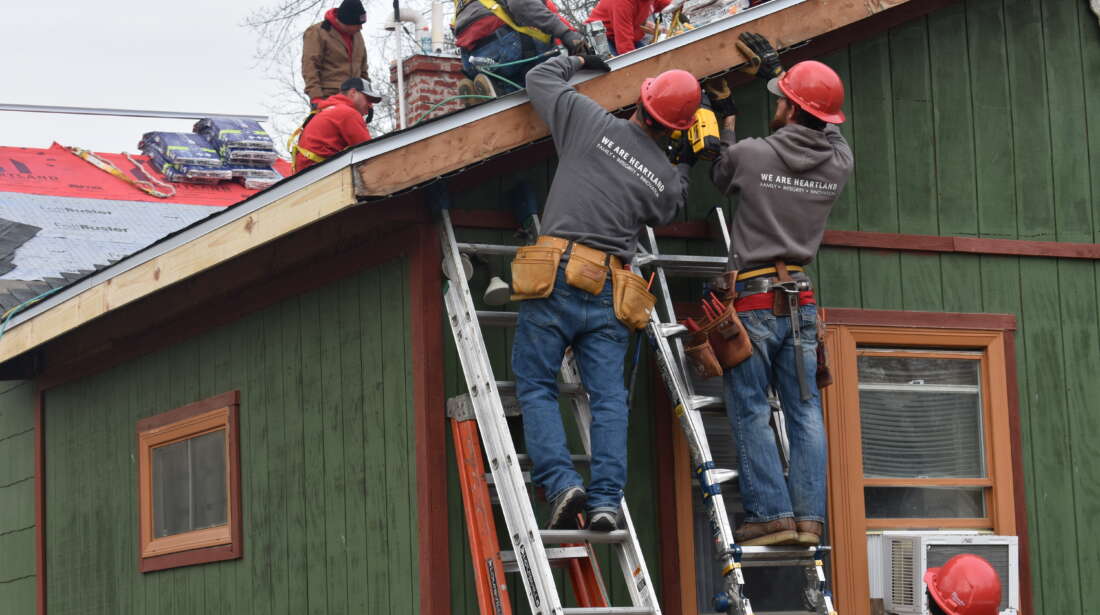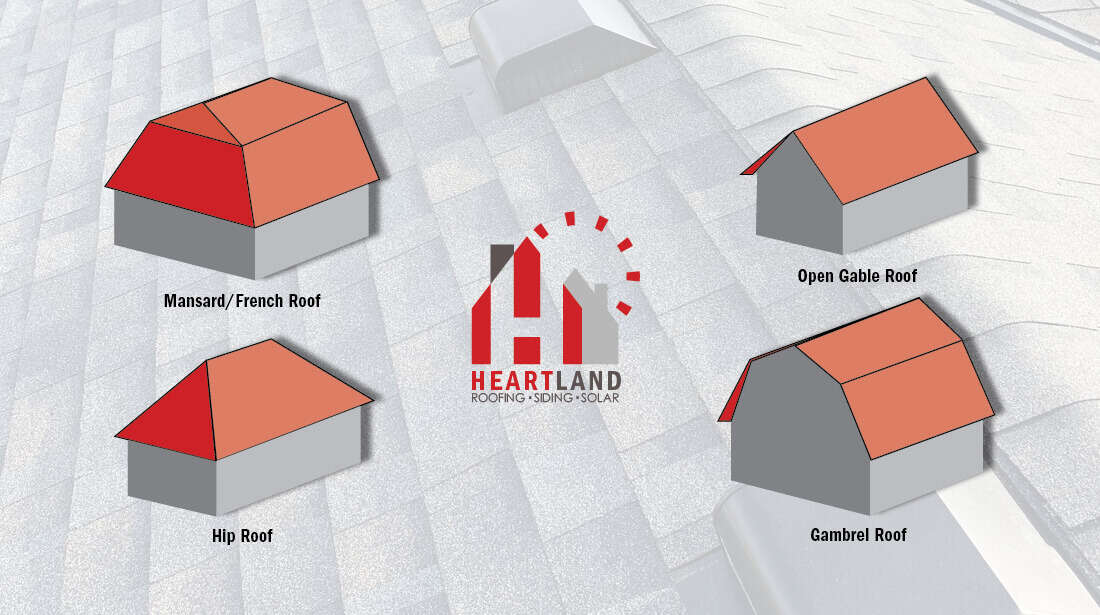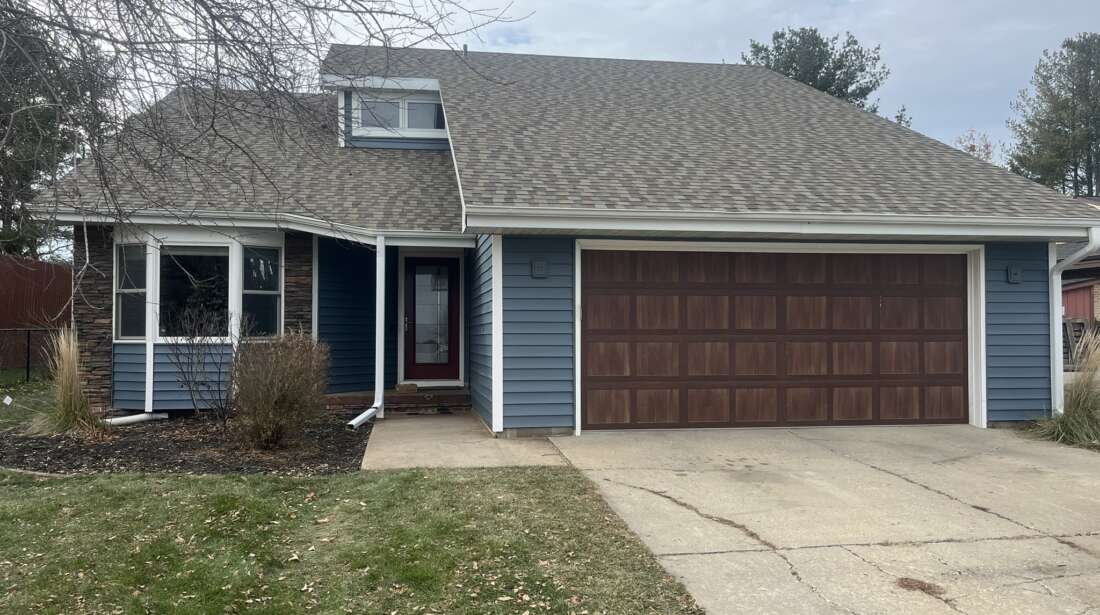When it comes to maintaining or upgrading your home, the roof is one of the most crucial aspects to consider. Whether you have an aging or damaged roof or are planning a new build, understanding roofing costs, materials and options is essential. This guide will walk you through everything you need to know about roofing, including roofing cost considerations, the best roofing material and design choices.
How Much Should You Spend on a Roof?
Determining how much to spend on a new roof involves a few key factors, including the size of your home, the roofing material you choose and any additional features you may want. Roofing costs can vary significantly based on these considerations, making it crucial to have an accurate estimate.
One of the most innovative tools available to homeowners for getting an estimate is the roofing cost calculator from Heartland Roofing, Siding, and Solar. After selecting the Instant Roof Quote icon on the website, getting started with this new roofing technology is as simple as entering the address of the home or building that needs a roof replacement. This tool allows you to get an accurate cost estimate for a new roof by inputting details about your home and roofing preferences. You can get a precise estimate range tailored to your specific needs, helping you budget effectively and make informed decisions about your roofing project.
While Heartland can’t control the size of your roof, its design or the material you choose, we can control the quality of service we provide and include that in our estimate. With so many roofing contractors available, it's important for homeowners to choose a company who priorities quality, reliability and customer satisfaction. So, some simply quote the cost of taking shingles off and putting shingles back on without replacing the felt or checking the flashings.
Some roofing contractors don’t include metal materials — like no flashing — in their instant quote tools and are quoting the cheapest materials, like tar paper instead of synthetic felt, to protect your roof from ice and water damage.
Heartland includes its standard ice and water shield, synthetic felt and flashing in the Instant Roof Quote tool available on our website because we want our customers to feel confident they’re getting a clear idea of what it will cost in the end.
When you request an instant quote, our team receives a notice, and someone will reach out to you shortly after to set up an in-person inspection to give you an even more in-depth and accurate estimate.

What Is the Best Roof for Your Money?
When considering what type of roof provides the best value for your money, several factors come into play, including longevity, maintenance requirements and overall cost. Asphalt shingles are a popular choice due to their affordability and ease of installation. However, if you’re looking for long-term savings and durability, you may consider materials such as metal roofing or high-quality tile.
Overall, it depends on what you, the homeowner, want for your home. Our team typically recommends asphalt shingles because it’s the best material for your money. When you step up to steel roofing, there are a wide variety of types of steel roofing styles available in shingles and in steel roofing panels that can range anywhere from $9 per square foot to $30 per square foot.
It's also important to choose a reputable contractor to ensure the job is done right. Avoiding bad roofing contractors is crucial for both the quality of the installation and the overall cost. Choosing the right contractor is essential to ensure both a high-quality installation and long-term value.
This can harm the quality of your roof in several ways. A contractor could not be installing the code-required amount of ice and water shield, a moisture-tight barrier that prevents leaks coming through the nail holes or other penetrations in the home’s roof. They might also skip putting in or replacing step flashing, a series of bent metal pieces installed in an overlapping stair-step pattern along the roofline where it meets a vertical surface — such as a wall or chimney — to prevent water from leaking into the walls as it flows down the roof.
When homeowners have what they think is a leak or water spots in their ceilings or walls, it’s our hope they’ll find Heartland. At Heartland, we're proud to have a dedicated service department and a fully staffed team ready to help.
When you’re ready to replace your roof, research contractors thoroughly and look for reviews from previous clients or recommendations from people you trust to ensure you're making the best choice for you and your home. We recommend getting at least three quotes before making your final decision on which local roofing contractor to choose to install or replace your roof.
How Much Does It Cost to Replace a Roof on a 1,600 Square Foot House?
Replacing a roof on a home of approximately 1,600 square feet can vary based on the material used and the complexity of the installation. On average, we would estimate the roofing cost for a home this size would range from $8,000 to $10,000.
When our Heartland team bids a roof, we look at everything that goes into it, including how high it is off the ground and how steep it is, or the pitch. The pitch is usually expressed in terms of 12 inches — so how many inches the roof runs vertically for every 12 inches it runs horizontally. If the height rises 2 inches vertically for every 12 inches of horizontal run, it has a 2/12 pitch. For Heartland, a 2/12 - 6/12 pitch is the cheapest, 0/12 - 2/12 requires special materials to do a flat roof section.
Using the Heartland roofing cost calculator can help you get a more precise estimate based on your specific needs. This instant roof quote tool, available on the right side of our website, accounts for factors such as the type of roofing material and any additional features you may want.
For a detailed estimate and more information on roofing costs, request a free quote from the Heartland team today using our contact us form. You can also use the instant quote tool, and someone from our team will connect with you to get an in-person inspection scheduled at a time that works best for you.
How Much Does It Cost to Replace a Roof on a 3000 Square Foot House?
For a larger home of approximately 3,000 square feet, the roofing cost will be higher. We estimate the cost to replace the roof would range from $15,000 to $18,000 — or higher — depending on the material and complexity of the installation.
If it were a ranch-style home with a 4/12 pitch and 230 square, and there's nothing extra on it, $13,000 would be a close estimate. If the project requires our team to use ladders longer than 26 feet, the estimate will be higher as this impacts our safety requirements and the use of additional equipment.
As with smaller homes, using a roofing cost calculator can provide a more accurate estimate tailored to your specific situation. This tool will help you understand the potential costs involved and assist in planning your budget effectively.
Which Roof Design Is Cheaper?
When considering roof designs, simplicity often equates to lower costs. Designs such as gable or hip roofs are generally less expensive than more complex structures, like mansard or gambrel roofs.
A straight-gable one-story home with a 4/12 pitch will likely be the cheapest and fastest roof to replace with very little waste.
A gable roof has two sloping sides that meet at a ridge, creating a triangular shape from the front and back, with a ridge that runs parallel to the length of the house. The other two sides of the roof have walls that extend from the bottom of the eaves to the peak of the ridge. The classic and simple shape makes the roofing easier to install with typically less material.
A hip roof is another popular choice, with all four sides of the roof sloping downward from a peak. Hip roofs are often on houses in suburban areas because of how easy they are to build.
Gambrel roof structures are slightly more complex. They have two sides, and each side has two slopes — where the lower slope is steeper than the upper slope. This style is most frequently seen on barns or Dutch colonial homes.
Mansard roof designs combine the double angle of a gambrel roof with the four-sided style of a hipped roof. They’re often known as a curb or French roof and can give the home a distinct look. However, mansard roofs can be susceptible to water damage if not installed and maintained properly. This style can also be expensive to construct and maintain, as mansard roofs have a steep pitch — almost as vertical as a wall in some instances.
Choosing a simpler design can not only reduce initial costs but also minimize potential maintenance expenses over time. Additionally, simpler designs may result in lower labor costs due to less intricate installation requirements.

What Goes on a Roof First?
Before the roofing material is installed, several essential components need to be in place. The first step is usually to remove any debris from the old roof, such as old layers of shingles, nails and other materials. Then Heartland will inspect the decking — the wooden boards, plywood or planks that make up the roof base — for any damage or rot and replace anything if necessary. Ensuring the home has healthy decking is critical, as this is the foundation of a solid roof system.
Once the decking is good to go, our team installs the ice and water shield first around the perimeter of the roof as well as in any spots where the roof and a wall meet. In Iowa, the International Residential Code (IRC) requires ice and water shields to extend from the eave of a building to at least 24 inches inside the interior wall line. For roofs with an 8/12 pitch or higher, the ice barrier must extend 36 inches along the roof slope from the eave edge. With most of the shield being available in 3-foot-wide rolls, one pass usually isn't enough to cover the distance between the drip edge and 2 feet past the interior wall. As a result, we usually choose to do a 6-foot swath of ice and water shield, or two rows of the material, and also add ice and water up the valleys to provide protection.
We typically then put the underlayment layer down to provide additional protection against water infiltration. In our case, we use a synthetic felt as a thin, water-resistant barrier to protect the roof from moisture, wind and other weather conditions that can cause leaks and damage the roof deck. It can also help improve the roof's efficiency by reducing heat loss.
Flashing is then installed. Flashing is a thin, waterproof material installed at critical areas of a roof — around joints, seams, and edges where the roof meets vertical surfaces, such as chimneys, vents, skylights and walls — to prevent water from seeping into the structure. It's typically made from materials like metal, rubber or plastic. Installing this element to any roof is essential as it directs water away from these vulnerable areas, preventing leaks and maintaining the integrity of the roofing material.
Proper installation of these components is crucial for ensuring the longevity and effectiveness of any home’s roof.
What Is the Best Roofing Material Today?
Selecting the best roofing material involves considering factors such as durability, cost and aesthetics. Currently, some of the top roofing materials include:
- Asphalt shingles: Asphalt shingles are durable, weather resistant and affordable. They can withstand many weather conditions, including hot summers, cold winters, rain, wind and hail. They are also resistant to fire, rot, mold, algae and mildew. With proper maintenance, asphalt shingles can last for around 20 years.
- Metal roofing: While asphalt shingles can trap water — and can eventually lift or crack if the water remains trapped on the roof — steel or metal roofing doesn't absorb any water, no matter the amount of rainfall. Steel roof shingles and panels are known for durability and energy efficiency; however, something to consider with Midwest weather is hail. If your steel roof is dented due to hail, it likely won’t be covered by insurance to replace it, as it will commonly be considered an aesthetic improvement. Be sure to double-check your policy
- Slate and tile: Known to offer a unique appearance and long life span, slate and tile roofing options often come with a higher price tag. Slate is a natural, dense and waterproof rock that's also fire and wind resistant. Tile can be made from clay or concrete, and both are waterproof and fireproof.
Asphalt roofing shingles are a versatile and cost-effective choice for many homeowners. To provide a balance between cost and durability, a steel roof with a hidden fastener system may be a great option.
Hidden fastener steel roofs are recommended for residential homes because the fasteners allow the metal to expand and contract freely during heat expansion. Exposed fasteners on metal roofs can’t do this, leading to potential issues with the holes in the washers over time. A metal roof can last much longer than other materials if maintained well, with some lasting between 50 and 100 years.

What Are the Top 5 Roofing Materials?
When evaluating roofing materials, we prioritize providing our homeowners with the best roofing solutions available to meet their needs and budget. So, realistically, there is not one best option. Most often, we consider these as the top five options:
- Metal roofing: Known for its durability and energy efficiency, metal roofing is often a top choice for homeowners seeking long-lasting protection and energy efficiency. Made from materials like aluminum, steel, copper or zinc, metal roofs can withstand harsh weather conditions, including heavy snow, strong winds and hail.
- Synthetic roofing shingles: Synthetic roofing shingles are an innovative alternative to natural materials, like slate, wood or asphalt. These offer the look of traditional materials but with enhanced durability and lower maintenance, making them a versatile and sometimes cost-effective option. One of the key advantages of synthetic shingles is their resistance to cracking, warping and other forms of damage caused by extreme weather conditions.
- Asphalt shingles: Economical and widely used, asphalt shingles provide reliable performance and come in various styles and colors to suit any home design. While not always a top choice in durability or longevity, they are the most widely available roofing material and the easiest for roofing contractors to install.
- Wood shakes and shingles: Wood shingles offer a classic style and durability. They can also be great for insulating your home but have some drawbacks, like their vulnerability to water and flammability.
- Clay roofing tiles: While not a material we typically use in the Midwest because of their tendency to shatter during hail storms, clay tiles offer a distinctive appearance and an unmatched longevity, making them ideal for homeowners who want a unique and durable roof.
At Heartland, we find that asphalt roofing shingles and metal shingles are among the most popular choices due to their balance of cost, durability and ease of maintenance. Whether you're looking for a modern or traditional aesthetic, these materials provide excellent options for protecting your home
What Type of Roof Is the Most Durable?
If durability is your primary concern, metal roofing is one of the most robust options available. It can withstand harsh weather conditions, resist fire and typically lasts between 40 to 70 years with minimal maintenance.
For metal roofing, even if it gets hit with hail, the damage would be aesthetic. When we put metal roofing on, we typically choose 26-gauge metal roofing to offer a thick, durable material. The strong metal is often coated for even further durability and performance.
Additionally, we carefully select the best shingle brands available in the area to ensure a durable and long-lasting solution for homeowners. For our steel roofing options, we regularly use Delta Metals out of Lamoni, Iowa, and Midwest Metal and Supply out of Cascade, Iowa.
How Long Do Roofs Last?
The lifespan of a roof in Iowa varies based on the material used and local weather conditions. Generally, asphalt shingles last about 20 to 30 years, while metal roofs can last 40–50 years or more.
Additionally, we carefully select the best shingle brands available in the area to ensure a durable and long-lasting solution for homeowners. At Heartland, we’ve been nominated in several Iowa counties as a top choice when it comes to the best roofing company.
When getting your quotes for a new roof, look for companies with a strong reputation and experience in the local market. Choosing a local company like Heartland ensures personalized care and long-term support for one of the most important investments in your home.
It’s our goal to be the best roofing company in Iowa and for you and your home. If you’re ready to get a quote, fill out this form or get your instant quote on our website today. We are eager to meet with you and give you a free home inspection.
Choosing the right roofing solution involves a combination of understanding costs, materials and design options. By using tools like Heartland’s instant roof quote and researching the local roofing contractors available in your area, you can make an informed decision that balances cost, durability and aesthetic appeal.
For personalized assistance with your roofing needs, don’t hesitate to reach out to anyone on our team. Our experts are here to help you find the best solution for your home.


